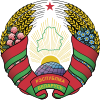Welcome to the Heraldry and Vexillology Portal!


Heraldry encompasses all of the duties of a herald, including the science and art of designing, displaying, describing and recording coats of arms and badges, as well as the formal ceremonies and laws that regulate the use and inheritance of arms. The origins of heraldry lie in the medieval need to distinguish participants in battles or jousts, whose faces were hidden by steel helmets.
Vexillology (from the Latin vexillum, a flag or banner) is the scholarly study of flags, including the creation and development of a body of knowledge about flags of all types, their forms and functions, and of scientific theories and principles based on that knowledge. Flags were originally used to assist military coordination on the battlefield, and have evolved into a general tool for signalling and identification, particularly identification of countries.
Selected coat of arms

The National Emblem of Belarus (Belarusian: Дзяржаўны герб Рэспублікі Беларусь, Russian: Государственный герб Республики Беларусь), which replaced the historic Pahonia arms in a 1995 referendum, features a ribbon in the colors of the national flag, the map of Belarus, wheat ears and a red star. It is sometimes referred to as the coat of arms of Belarus, which is incorrect due to lack of several heraldic elements. The emblem is an allusion to the one used by the Byelorussian SSR, designed by I.I. Dubasov in 1950. Emblems reminiscent of the times of the Soviet Union are also used by the nations of Tajikistan and Uzbekistan and the region of Transnistria. (more...)
Selected article

Canadian heraldry refers to the cultural tradition and style of coats of arms and other heraldic achievements in modern and historic Canada, including national, provincial, and civic arms, noble and personal arms, ecclesiastical heraldry, heraldic displays as corporate logos, and Canadian heraldic descriptions.
Canadian heraldry derives mainly from heraldic traditions in France and the United Kingdom while adding distinctly Canadian symbols, especially those which reference the First Nations and other aboriginal peoples of Canada. Canadian heraldry has a unique system of cadency for daughters inheriting arms, and a special symbol for United Empire Loyalists. Since 1988, both personal and corporate heraldry in Canada is officially governed by the Canadian Heraldic Authority, which reviews all applications for arms. (more...)
Selected flag

The National Flag of Canada, also known as the Maple Leaf, and l'Unifolié (French for "the one-leafed"), is a red flag with a white square in its centre, featuring a stylized 11-pointed red maple leaf. Its adoption in 1965 marked the first time a national flag had been officially adopted to replace the Union Flag. The Canadian Red Ensign had been unofficially used since the 1890s and was approved by a 1945 Order-in-Council for use "wherever place or occasion may make it desirable to fly a distinctive Canadian flag". In 1964, Prime Minister Lester B. Pearson appointed a committee to resolve the issue, sparking a serious debate about a flag change. Out of three choices, the maple leaf design by George F. G. Stanley was chosen. The flag made its first appearance on February 15, 1965; the date is now celebrated annually as Flag Day. Other flags have been created for use by Canadian officials, government bodies, and military forces. (more...)
Selected picture

A medieval ship flag captured by forces from Lübeck in the 1420s showed the arms of Denmark, Sweden, Norway and Pomerania. It remained in this city for 500 years, until destroyed in a World War II bombardment that damaged St. Mary's Church where the flag was kept. A 19th century copy remains in Frederiksborg Palace, Denmark. The saint accompanying the Virgin Mary and infant Christ is Saint James the Greater, identified by his scallop shell emblem. The flag was made of coarse linen; all figures and heraldic insignia were created using oil-based paint.
Did you know...
- ...that during the Indonesian National Revolution the first Indonesian flag, Bendera Pusaka (first hoisting pictured), was cut in half to save it from the Dutch military forces?
- ...that John Anstis became Garter Principal King of Arms in 1718, after trying for almost a decade to get the appointment?
- ...that the Dering Roll begins with the coats of arms of two illegitimate sons of King John of England?
- ...that the Raven banner, a standard used by various Viking leaders including Sigurd the Stout and Harald III of Norway, was a totem believed to have the power to grant victory to its holder?
- ...that Hinke Bergegren's Under röd flagg was the first periodical to introduce detailed accounts of anarchist thought in Sweden?
Related portals
Major topics and navigation
|
|
|
Heraldry Web resources
Authorities
- Belgium - The Council of Nobility, Flemish Heraldic Council and Council of Heraldry and Vexillology of the French Community
- Canada - Canadian Heraldic Authority and see also Public Register of Arms, Flags and Badges
- England, Wales, and Northern Ireland - The College of Arms
- Ireland - The Office of the Chief Herald of Ireland
- Netherlands - High Council of Nobility
- Portugal - Instituto da Nobreza Portuguesa
- Scotland - The Court of the Lord Lyon
- South Africa - South African Bureau of Heraldry
- Sweden - National Board of Heraldry, The National Archive
- United States Army - The United States Army Institute of Heraldry
Societies
- Greek Heraldry Society
- The Academy of Heraldic Science Czech republic
- The American College of Heraldry
- The American Heraldry Society
- The Augustan Society
- The Australian Heraldry Society Inc.
- Bulgarian Heraldry and Vexillology Society
- The Center for Research of Orthodox Monarchism
- Cambridge University Heraldic and Genealogical Society
- Chiltern Heraldry Group
- The College of Dracology
- Croatian Heraldic and Vexillologic Association
- The Finnish Heraldic Society
- Fryske Rie foar Heraldyk
- Hellenic Armigers Society
- Guild of Heraldic Artists
- Genealogical Society of Ireland
- Heraldry Research Institute (Japan)
- The Heraldry Society
- The Heraldry Society of Africa
- The Heraldry Society of New Zealand Inc.
- The Heraldry Society of Scotland
- The Heraldry Society of Southern Africa
- The Institute of Heraldic and Genealogical Studies
- The International Association of Amateur Heralds
- Italian Center of Vexillological Studies
- Lancashire Heraldry Group
- Macedonian Heraldry Society
- New England Historic Genealogical Society Committee on Heraldry
- Norwegian Heraldry Society
- Oxford University Heraldry Society
- Polish Heraldry Society
- Polish Nobility Confederation
- Real Academia Matritense de Heráldica y Genealogía - Royal Academy of Heraldry and Genealogy of Madrid
- Romanian Institute for Genealogy and Heraldry
- The Royal Heraldry Society of Canada
- The Russian College of HeraldryThe Russian College of Heraldry
- Serbian Heraldic Society
- Societas Heraldica Scandinavica
- Societas Heraldica Slovenica
- Swedish Heraldic Society
- Ukrainian Heraldry Society
- Royal Association Genealogical and Heraldic Office of Belgium
Vexillology
Software
- Coat of Arms Visual Designer web-based program
- Puncher Heraldry Program
- Blazonry Server - pyBlazon
- DrawShield - creates SVG shield or arms image from blazon
- CoaMaker - web-based tool
- Blazon95 and BLAZONS! 2000, older Windows applications
- Heraldicon
Texts
- Heraldry, historical and popular : with seven hundred illustrations (1863)
- A Complete Guide to Heraldry (1909)
Other
Wikimedia
The following Wikimedia Foundation sister projects provide more on this subject:
-
Commons
Free media repository -
Wikibooks
Free textbooks and manuals -
Wikidata
Free knowledge base -
Wikinews
Free-content news -
Wikiquote
Collection of quotations -
Wikisource
Free-content library -
Wikispecies
Directory of species -
Wikiversity
Free learning tools -
Wikivoyage
Free travel guide -
Wiktionary
Dictionary and thesaurus











